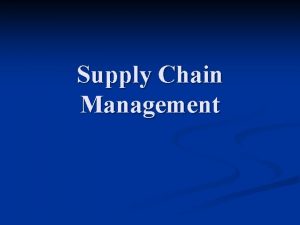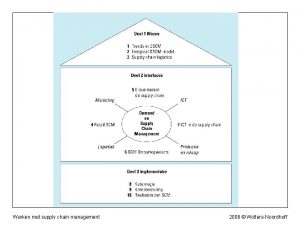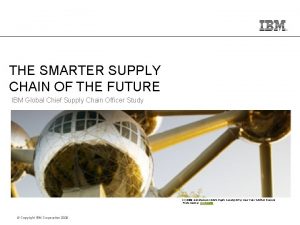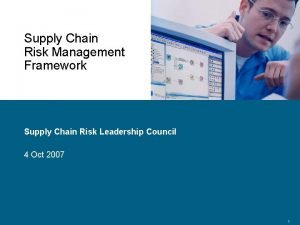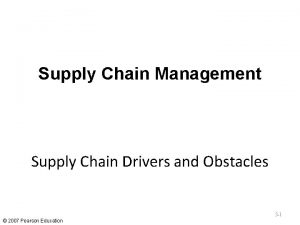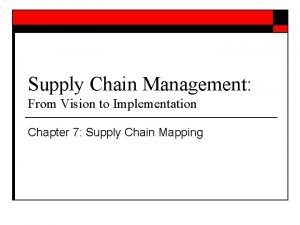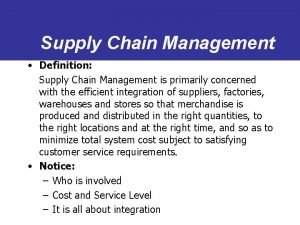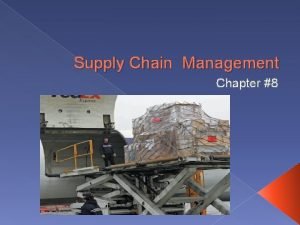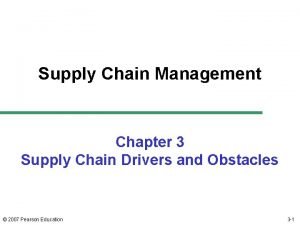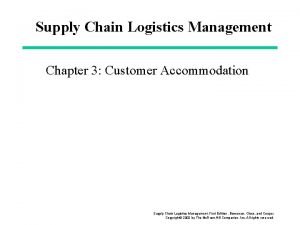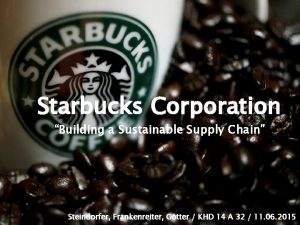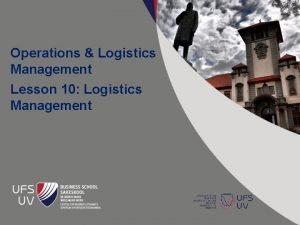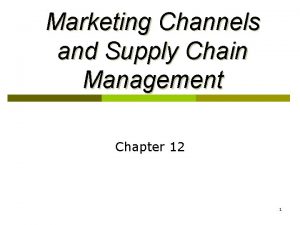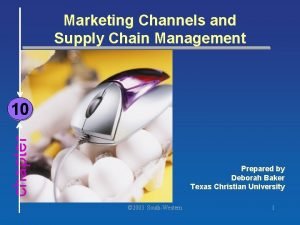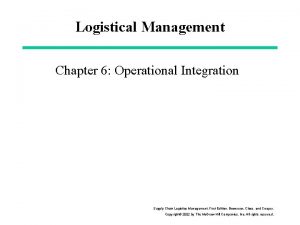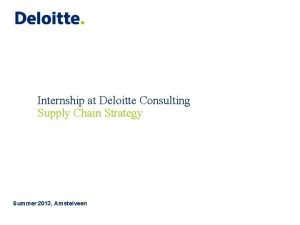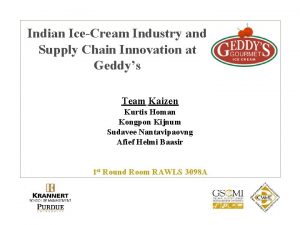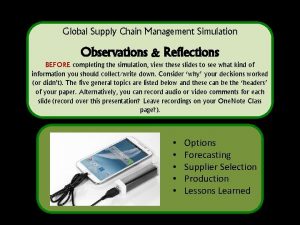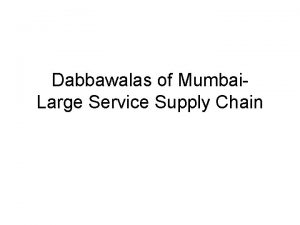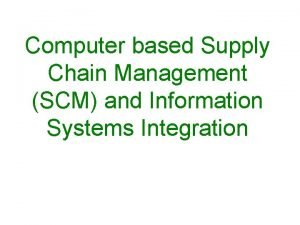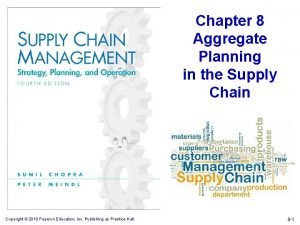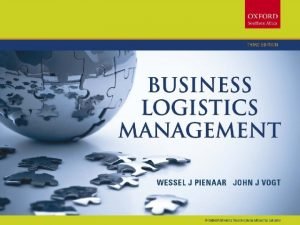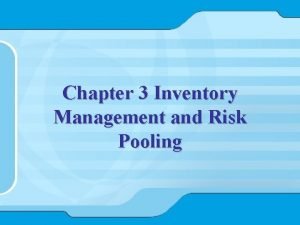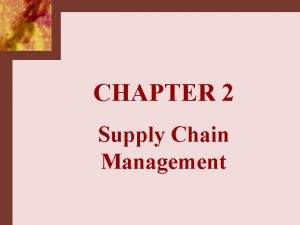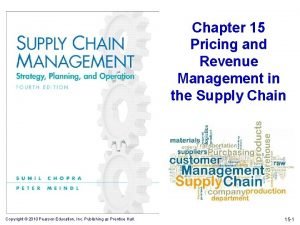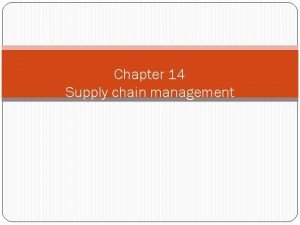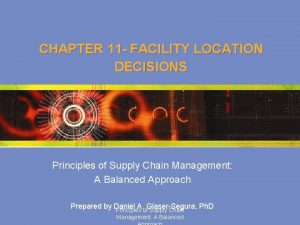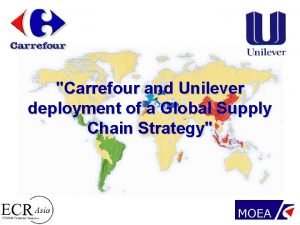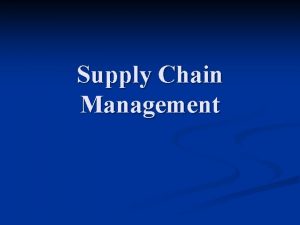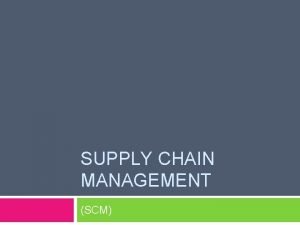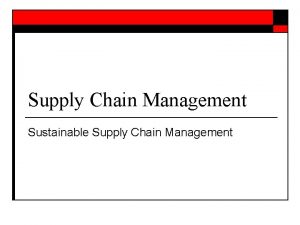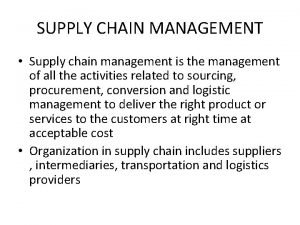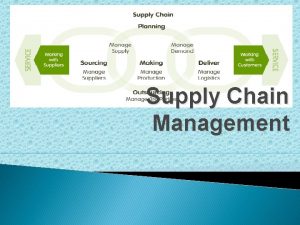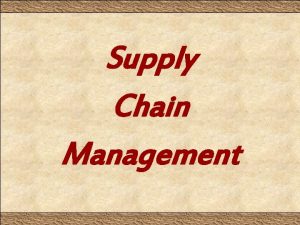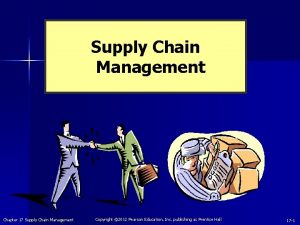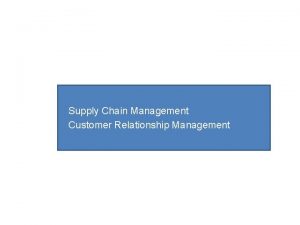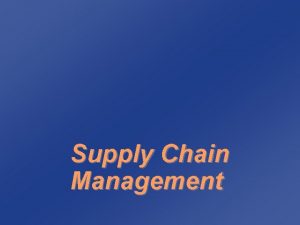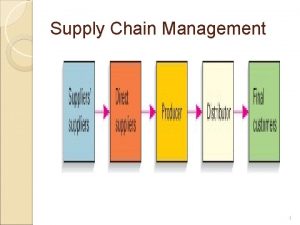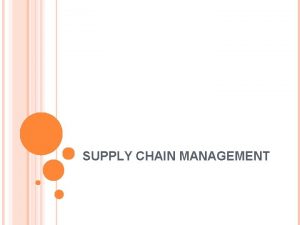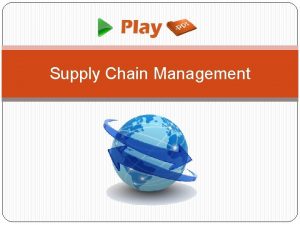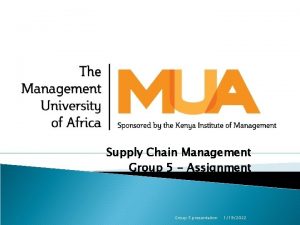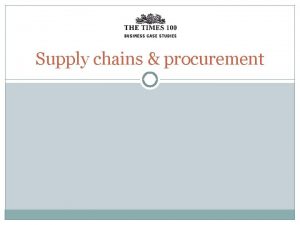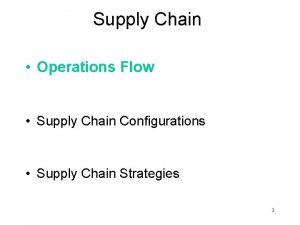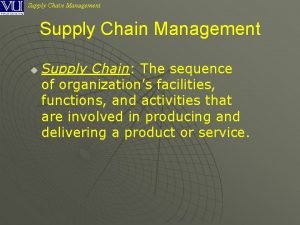Unit 2 Start Supply Chain Supply Chain Management






































- Slides: 38

Unit 2 Start Supply Chain

Supply Chain Management Supply chain management is a wide term that includes all aspects of the supply chain: 1. Scheduling 2. Transportation 3. Pricing 4. Inventory 5. Procurement

How Important is it n n n Supply chain management is key for retail and manufacturing. It combines inventory, purchasing, production capacity, and transportation into a single “modeling” approach. Many significant success stories. Walmart (cross dock), Dell, Boeing (good and bad case studies), … Supply chain management is a wide view of the world that includes materials management, inventory, purchasing, distribution. Many vendors (SAP APO/ Oracle/ i 2 / Manu/ …). Supply chain was a hot area for startup companies (ie/ Manu), but now is often supported by ERP system modules.

Analytical Methods to Support SCM implementation The transportation problem and more general network formulations for describing flow of goods in a complex system n Vehicle routing problem n Inventory management and demand forecasting models such as those discussed in this course n Analytical support methods for procurement and contracting. n

Supply Chain Management (Book Slide) Important activities include determining 1. Transportation vendors 2. Credit and cash transfers 3. Suppliers 4. Distributors 5. Accounts payable and receivable 6. Warehousing and inventory 7. Order fulfillment 8. Sharing customer, forecasting, and production information © 2011 Pearson Education, Inc. publishing as Prentice Hall

A Supply Chain for Beer (Book Slide) © 2011 Pearson Education, Inc. publishing as Prentice Hall Figure 11. 1

How Supply Chain Decisions Impact Strategy (Book Slide) Low-Cost Strategy Response Strategy Differentiation Strategy Supplier’s goal Supply demand at lowest possible cost (e. g. , Emerson Electric, Taco Bell) Respond quickly Share market to changing research; requirements jointly develop and demand to products and minimize options (e. g. , stockouts (e. g. , Benetton) Dell Computers) Primary selection criteria Select primarily for cost Select primarily for capacity, speed, and flexibility © 2011 Pearson Education, Inc. publishing as Prentice Hall Select primarily for product development skills Table 11. 1

How Supply Chain Decisions Impact Strategy (Book Slide) Low-Cost Strategy Response Strategy Differentiation Strategy Process characteristics Maintain high average utilization Invest in excess capacity and flexible processes Modular processes that lend themselves to mass customization Inventory characteristics Minimize inventory throughout the chain to hold down cost Develop responsive system with buffer stocks positioned to ensure supply Minimize inventory in the chain to avoid obsolescence © 2011 Pearson Education, Inc. publishing as Prentice Hall Table 11. 1

How Supply Chain Decisions Impact Strategy (Book Slide) Low-Cost Strategy Response Strategy Differentiation Strategy Lead-time characteristics Shorten lead time as long as it does not increase costs Invest aggressively to reduce production lead time Invest aggressively to reduce development lead time Productdesign characteristics Maximize performance and minimize costs Use product designs that lead to low setup time and rapid production ramp-up Use modular design to postpone product differentiation as long as possible © 2011 Pearson Education, Inc. publishing as Prentice Hall Table 11. 1

Supply Chain Economics (Book Slide) Supply Chain Costs as a Percent of Sales Industry All industry Automobile Food Lumber Paper Petroleum Transportation © 2011 Pearson Education, Inc. publishing as Prentice Hall % Purchased 52 67 60 61 55 79 62 Table 11. 3

Supply Chain Economics (book slide) Dollars of additional sales needed to equal $1 saved through the supply chain Percent of Sales Spent in the Supply Chain Percent Net Profit of Firm 2 4 6 8 10 © 2011 Pearson Education, Inc. publishing as Prentice Hall 30% $2. 78 $2. 70 $2. 63 $2. 56 $2. 50 40% $3. 23 $3. 13 $3. 03 $2. 94 $2. 86 50% $3. 85 $3. 70 $3. 57 $3. 45 $3. 33 60% $4. 76 $4. 55 $4. 35 $4. 17 $4. 00 70% $6. 25 $5. 88 $5. 56 $5. 26 $5. 00 80% $9. 09 $8. 33 $7. 69 $7. 14 $6. 67 90% $16. 67 $14. 29 $12. 50 $11. 11 $10. 00 Table 11. 4

Make-or-Buy Decisions Choice between internal production and external sources n Reasons to make – Low cost, protect intellectual property, unable to buy, quick response, … n Reasons to buy – Low cost, protect intellectual property, unable to buy, quick response, … n

Outsourcing (Book Slide) u Transfers traditional internal activities and resources of a firm to outside vendors u Utilizes the efficiency that comes with specialization u Firms outsource information technology, accounting, legal, logistics, and production © 2011 Pearson Education, Inc. publishing as Prentice Hall

Supply Chain Strategies (Book Slide) u Negotiating with many suppliers u Long-term partnering with few suppliers u Vertical integration u Joint ventures u Keiretsu u Virtual companies that use suppliers on an as needed basis © 2011 Pearson Education, Inc. publishing as Prentice Hall

Many Suppliers (Book Slide) u Commonly used for commodity products u Purchasing is typically based on price u Suppliers compete with one another u Supplier is responsible for technology, expertise, forecasting, cost, quality, and delivery © 2011 Pearson Education, Inc. publishing as Prentice Hall

Few Suppliers (Book Slide) u Buyer forms longer term relationships with fewer suppliers u Create value through economies of scale and learning curve improvements u Suppliers more willing to participate in JIT programs and contribute design and technological expertise u Cost of changing suppliers is huge © 2011 Pearson Education, Inc. publishing as Prentice Hall

Vertical Integration (Book Slide) Vertical Integration Raw material (suppliers) Backward integration Examples of Vertical Integration Iron ore Silicon Farming Flour milling Steel Current transformation Automobiles Integrated circuits Forward integration Distribution systems Circuit boards Dealers Computers Watches Calculators Finished goods (customers) © 2011 Pearson Education, Inc. publishing as Prentice Hall Baked goods Figure 11. 2

Vertical Integration (Book Slide) n n Developing the ability to produce goods or service previously purchased Integration may be forward, towards the customer, or backward, towards suppliers Can improve cost, quality, and inventory but requires capital, managerial skills, and demand Risky in industries with rapid technological change © 2011 Pearson Education, Inc. publishing as Prentice Hall

Joint Ventures (Book Slide) n Formal collaboration Enhance skills n Secure supply n Reduce costs n n Cooperation without diluting brand or conceding competitive advantage © 2011 Pearson Education, Inc. publishing as Prentice Hall

u Keiretsu Networks (Book Slide) A middle ground between few suppliers and vertical integration u Supplier becomes part of the company coalition u Often provide financial support for suppliers through ownership or loans u Members expect long-term relationships and provide technical expertise and stable deliveries u May extend through several levels of the supply chain © 2011 Pearson Education, Inc. publishing as Prentice Hall

Virtual Companies (Book Slide) u Rely on a variety of supplier relationships to provide services on demand u Fluid organizational boundaries that allow the creation of unique enterprises to meet changing market demands u Exceptionally lean performance, low capital investment, flexibility, and speed © 2011 Pearson Education, Inc. publishing as Prentice Hall

Who runs the supply chain n n In House Outsourced Outsouring is very common for the transportation component of the supply chain and less common for the inventory and procurement. 3 pl provide many services for transportation n n Booking, tariffs (AP/AR), contracting with carriers, match pay, track and trace We will discuss transportation at length during our next lecture.

Efficient Design of the Supplier Base Minimize the number of suppliers to control quality and facilitate cooperation. n Select supply base in “low cost” countries. Make sure to consider total landed cost: n Transportation n Inventory n Quality n Lead time n Risk n n Use modules instead of individual parts.

Supply Chain Strategy Postponement n n Withholds any modification or customization to the product (keeping it generic) as long as possible Example n n After analyzing the supply chain for its printers, HP determined that if the printer’s power supply was moved out of the printer itself and into a power cord, HP could ship the basic printer anywhere in the world HP modified the printer, its power cord, its packaging, and its documentation so that only the power cord and documentation needed to be added at the final distribution point

Supply Chain Strategy – Channel Assembly n Channel assembly Variation of postponement n Sends the individual components and modules, rather than finished products, to the distributor n The distributor then assembles, tests, and ships n This technique has proven successful in industries where products are undergoing rapid change, such as personal computers (WHY? ) n

Supply Chain Strategy – Direct or Drop Shipping n Direct shipping and special packaging Drop shipping means the supplier will ship directly to the end customer, rather than to the seller, saving both time and reshipping costs n Other cost-saving measures include the use of special packaging, labels, and optimal placement of labels and bar codes on containers n

Blanket Orders n Blanket orders are unfilled orders with a vendor n A blanket order is a contract to purchase certain items from the vendor n It is not an authorization to ship anything n Shipment is made only upon receipt of an agreed-upon document, perhaps a shipping request or shipment release n n Contracted Parts

n Supply Chain Strategy – Stockless Purchasing (from book) Stockless purchasing means that the supplier maintains inventory that is delivered directly to the purchaser’s using department rather than to a stock room n If the supplier can maintain the stock of inventory for a variety of customers who use the same product or whose differences are very minor (say, at the packaging stage) then there may be a net savings n

Standardization n n n The purchasing department should make special efforts to increase levels of standardization That is, rather than obtaining a variety of similar components with labeling, coloring, packaging, or perhaps even slightly different engineering specifications, the purchase agent should try to have those components standardized Avoid unnecessary part proliferation. n n Marketing wants part proliferation. Supply chain wants to avoid part proliferation.

VMI n n Vendor Managed Inventory is an overused term in industry. It is a family of policies where the supplier take full responsibility for maintaining the inventory n n n Typically the inventory is located at the buyers location (warehouse / store) Terms of sale in a vendor managed inventory environment make the manufacturing typically responsible for unsold items. Consignment stock is a related type of VMI.

VMI n n VMI in manufacturing requires that the supplier assume the role of managing inventory levels. The close relationship between the supplier and customer insures good communication of information (supplier see stock levels). VMI has many forms but in general it requires that the supplier take reasonability (inventory / transportation maybe) for the good later in the process. Supplier controlled warehouse is similar to VMI but the customer owns the material and the supplier is responsible for warehousing and transportation to the warehouse point.

EDI n Transactions between forms often use electronic data interchange (EDI) n n Standardized data-transmittal format for computerized communications between organizations An extension of EDI is Advanced Shipping Notice (ASN), which is a shipping notice delivered directly from the vendor to purchaser When the vendor is ready to ship, shipping labels are printed and the ASN is created and transmitted to the purchaser EDI is being converted from private networks to internet (XML) based standards.

EDI n n EDI: Electronic Data Interchange. A transmisson of a documents electronically in a predetermined format from company to company. Not web based or XLM Based. The formats are complex and expensive. Pure EDI appears to be on the decline (or evolve) as web-based / XML systems grow. Restated, EDI is a “slightly” outdated term but EDI systems are still in wide use. (My comment)

EDI Formats n n EDI Formats are difficult. Lets review roadways document for generating 214 (easiest). A list of key transportation messages from wikipedia and roadway n 104 Air Shipment Information 106 Motor Carrier Rate Proposal 107 Request for Motor Carrier Rate Proposal 108 Response to a Motor Carrier Rate Proposal 110 Air Freight Details and Invoice n 204 Motor Carrier Load Tender n 210 Motor Carrier Freight Details and Invoice 211 Motor Carrier Bill of Lading n n n 212 Motor Carrier Delivery Trailer Manifest 213 Motor Carrier Shipment Status Inquiry n 214 Transportation Carrier Shipment Status Message n n 215 Motor Carrier Pick-up Manifest n 216 Motor Carrier Shipment Pick-up Notification n 217 Motor Carrier Loading and Route Guide 218 Motor Carrier Tariff Information 250 Purchase Order Shipment Management Document 251 Pricing Support 601 U. S. Customs Export Shipment Information 602 Transportation Services Tender 715 Intermodal Group Loading Plan 920 Loss or Damage Claim - General Commodities n 997 – Functional Acknowledgement n n n n

Warehousing Can be an in house or outsourced function. n Outsourced warehouses can be billed based on many different measures. n Warehousing is often a consideration for inventory and supply chain problems. n

Globalization n n Important to look for the best price for purchased items (as discussed last lecture). Foreign suppliers might reduce cost for some parts and services. Examine total landed cost! n n n n n Part Price Tariff and duties Quality Transportation Inventory Warehousing Risk (supply and supply chain) Make selection based on total landed cost. Understand the quality and capability of all suppliers.

Global Concerns in SCM (book slide) n Moving manufacturing offshore to save direct costs complicates and adds expense to supply chain operations, due to: increased inventory in the pipeline n Infrastructure problems n Political problems n Dealing with fluctuating exchange rates n Obtaining skilled labor n

Globalization Examine global “tooling” options with suppliers. n Global programs (items built in more then one location) might justify multiple tool sets (location of part production). n How many tooling sets and the location of the sets is a “medium term” decision. n Key is a good understanding of total landed cost. n
 Crm vs scm
Crm vs scm Contemporary issues in operations management ppt
Contemporary issues in operations management ppt Sequence in supply chain
Sequence in supply chain Matching supply and demand in supply chain
Matching supply and demand in supply chain If you gotta start somewhere why not here
If you gotta start somewhere why not here Start/jump start triage algorithm
Start/jump start triage algorithm What is logistics management
What is logistics management Grazing food chain diagram
Grazing food chain diagram Werken met supply chain management noordhoff
Werken met supply chain management noordhoff Ibm supply chain strategy
Ibm supply chain strategy Supply chain risk management framework
Supply chain risk management framework Supply chain risk management framework
Supply chain risk management framework Risk assessment likelihood
Risk assessment likelihood Framework for structuring drivers
Framework for structuring drivers Pipeline in supply chain
Pipeline in supply chain Supply chain management definition
Supply chain management definition Supply chain upstream and downstream
Supply chain upstream and downstream Drivers in supply chain
Drivers in supply chain What is the developing customer accommodation strategy?
What is the developing customer accommodation strategy? Starbucks supply chain diagram
Starbucks supply chain diagram Logistics management introduction
Logistics management introduction Conventional marketing channel
Conventional marketing channel Marketing channels and supply chain management
Marketing channels and supply chain management Chapter 6 supply chain management
Chapter 6 supply chain management Principes fondamentaux supply chain management pdf
Principes fondamentaux supply chain management pdf Deloitte supply chain risk management
Deloitte supply chain risk management Supply chain management in ice cream industry
Supply chain management in ice cream industry Global supply chain management simulation
Global supply chain management simulation Ford mp&l
Ford mp&l Dabbawala supply chain management
Dabbawala supply chain management Computer based supply chain management
Computer based supply chain management Aggregate planning solved examples
Aggregate planning solved examples Supply chain strategic planning
Supply chain strategic planning Inventory pooling examples
Inventory pooling examples Cscmp definition of supply chain management
Cscmp definition of supply chain management Role of pricing and revenue management in a supply chain
Role of pricing and revenue management in a supply chain Benefits of supply chain management
Benefits of supply chain management Location
Location Carrefour supply chain strategy
Carrefour supply chain strategy


